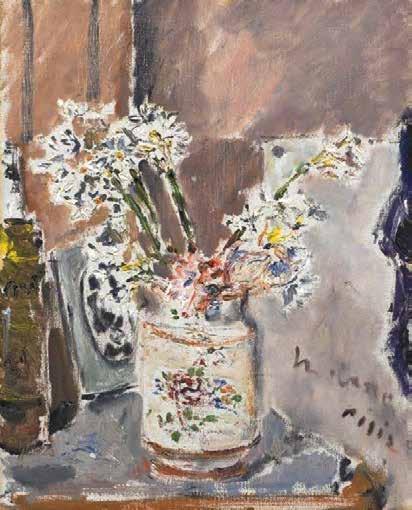
4 minute read
Formative Years
Piero and Gloria CIcionesi
page 28
Advertisement
Sand-mining flatboat on River Po, Turin, ink drawing on paper.
Piero Cicionesi
Born in 1935, just before the troubled war years in Italy, Piero recalls his childhood and early family life with a sense of fondness, more appropriately described as a sense of “Gemütlichkeit!” 1
His early education was in a German school, under the influence of his German mother. Towards the end of the Second World War, the school was closed down and the teachers had to flee. Piero and his brother were shifted to an Italian school in Florence. He reminisces, “When I was a boy I showed a special talent in design, in drawings, in painting, in colour, and when I discovered this myself I was 14 or 15 years old. I still have a vivid memory of my first drawings and, by chance, they were linked with architecture. They were of houses, old houses… a bit picturesque probably. I tried oil colours and then watercolour paintings…”
In those post-war formative years, the paintings of Filippo de Pisis 2 left a deep impression on Piero’s young mind. He recalls, “The paintings of Pisis impressed me very much. I had seen a big exhibition in Florence on him. I was very impressed because he had these very rapid strokes of the brush. In three-four strokes it was already defined. I tried out painting in that manner.”
Another early attribute was Piero’s proficiency in mathematics, one that grounded the artist in him with a rational, logical understanding of structure. Many years later, it was this synthesis of art and math that emerged strongly when Piero began work on the complex structural drawings of the Matrimandir in Auroville. 3
Piero recalls an exhibition organized by a renowned Italian critic in 1951 on the “Life Work of Frank Lloyd Wright” that left a deep impact on his mind.
above City of Florence
left Watercolour painting, Piero, 1952


right Oil painting, Filippo de Pisis, 1896–1956

above Falling Water, Frank Lloyd Wright
below ‘Garden of Sculptures’, designed by Carlo Scarpa at the Venice Biennale, 1952
The exhibition had models, original sketches and drawings displayed in a famous gallery of Florence. In Piero’s words, “I saw his drawings and was touched by the experience of seeing the harmony, which was so much in contrast to the chaos of colour and form that I was to see later in the art at the Venice Biennale. The impressive architecture of Wright coming out of these vivid, mostly pencil, drawings was a language that I was able to read and intuitively understand. I felt I would like to do that too. I learned to describe the experience much later, through the words of critic Paul Goldberger, who said about one of Wright’s most celebrated creations, Falling Water: ‘Like any kind of great art, it ultimately takes you somewhere that words cannot take you.’ And it was in 1952, when I was 17, that I decided to go to Venice for the Biennale.”

The Venice Art Biennale had an international exhibition of modern paintings. The young, idealistic Piero took a train and reached Venice with a sketchbook in hand. The Biennale left him shocked by the sheer range and quantity of work. “It was like a maze. The jungle of abstract, formal, informal, and all kinds of artwork was an overwhelming experience and I felt like an outsider with my modest sketching and painting,” says Piero. However, by chance, the Biennale also introduced him to the original and imaginative works of Italian architect Carlo Scarpa.
Describing the experience, Piero recounts, “Scarpa had designed a Pavilion and restored an old building for the exhibition with a fantastic intuition. You have a very well-defined way through the maze of paintings and at its end, you find suddenly a round opening. You reach the opening and what do you see there? The blue water of the canal, gently cooling off your agitated mind! That sort of a surprise element! You see an
ARCHITECTURE AUROVILLE ARCHITECTS MONOGRAPH SERIES Piero and Gloria Cicionesi Mona Doctor-Pingel
204 pages, 256 photographs and 117 b&w drawings, 9 x 9” (229 x 229 mm), hc ISBN: 978-93-85360-41-1 ₹2750 | $50 | £37 Spring 2018 • World rights
Mona Doctor-Pingel studied architecture at CEPT University, Ahmedabad and completed post-graduation in Appropriate Technology from Flensburg University, Germany. Since 1995 she has an independent practice in Auroville, Studio Naqshbandi, where she explores architecture, interiors and landscape design. One of the guiding principles in her work is the creation of buildings that are healthy (Baubiologie), aiming to find the right balance between Man–Nature–Economy.
She is actively involved in teaching and conducting workshops, and has been part of various Auroville Planning bodies. Since 2012 she is a part of a five-year Indo-US joint research programme on “Energy Efficiency in Buildings”. Being rooted in Auroville and the local context of rural Tamilnadu has given her a unique opportunity to understand that “slowing down is the first step to sustainability.”
She has initiated and authored a series of monographs on Auroville architects—The Pioneers, the first of which on Poppo Pingel was published by Mapin in 2012.
OTHER TITLES OF INTEREST Brinda Somaya Works and Continuities Curated by Ruturaj Parikh • Edited by Nandini Somaya Sampat
Wooden Architecture of Kerala Miki Desai
Courtyard Houses of India Yatin Pandya
Mapin Publishing www.mapinpub.com




